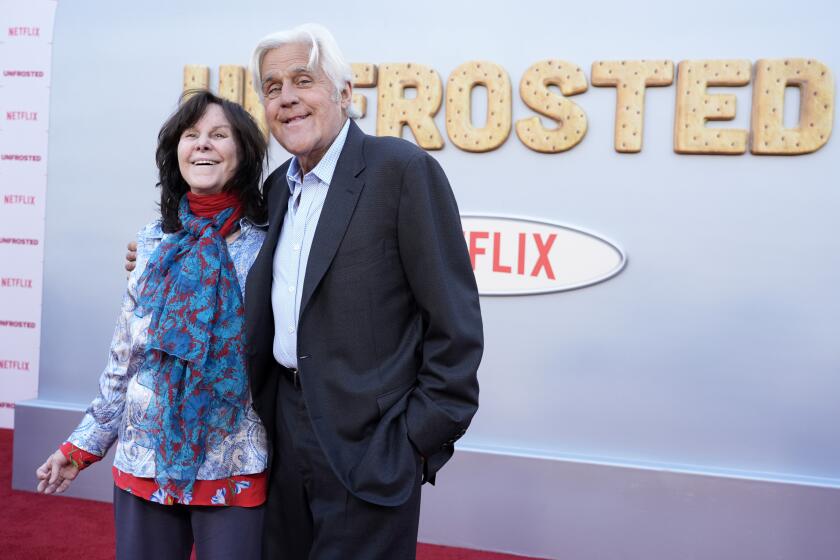THEATER / RICK VANDERKNYFF : Making It Up as He Goes Along : Director, Playwright and Acting Instructor Greg Atkins Happened Into Writing a Book on Improv
- Share via
T wo old friends are waiting for a bus in Miami. A bee buzzes around them. Then another. Then another. Now a swarm of bees surrounds them.
Although this may read like the setup for a scene from “America’s Funniest Home Videos,” it’s actually an exercise from “Improv! A Handbook for the Actor” (Heinemann, $13.95), by Greg Atkins, an active playwright, director and acting instructor in Orange County.
The suggested scenario is from “Bus Stop,” a playwriting exercise for two actors that forces performers to create their own scenes.
In “Foreign Film,” an exercise for four actors, two actors create a scene from an imaginary foreign-language film, speaking only gibberish, while the two remaining actors translate the scene into English. In “Age Walk,” a group of actors walks in a circle; as someone calls out a series of ages, the actors become that age.
“My students tend to be very open to trying anything,” Atkins said during an interview in the Costa Mesa courtyard outside South Coast Repertory, where he teaches in the conservatory programs for both young and adult actors.
The point of the exercises, he explained, is to “liberate spontaneity,” to help actors lose their fear, make decisions and “think quickly on their feet.”
Many actors, he said, spend a lot of time on the physical aspects of performing but not enough on the mental: “This book breaks down the acting process to the basic components.”
Atkins has taught improvisation and other topics related to acting for 13 years at SCR. In that time, he’s developed an approach to improvisation that he expands in the book, his first. Diane Doyle, founder and director of the Young Conservatory, “literally gave me a playground here to explore,” Atkins said.
The approach works to improve several aspects of acting, he said, but it also works with students who may never act on stage, who take his classes to gain poise and confidence in other professions and in their personal lives.
Improv, Atkins said, is the “jazz of theater. . . . You’re up there jamming, creating.” Improvisation can be an end in itself--more than one improv group has been born in Atkins’ classes--but also, and perhaps more important, it sharpens general performing and writing skills and the ability to cope in audition situations.
“I find that the improv I do really helps me as a playwright,” Atkins said.
*
The Lakewood resident has written several children’s plays that he has directed on Orange County stages, including the Gem Theatre in Garden Grove, the Irvine Barclay Theatre and SCR.
He also works as a consultant with Disney, helping to create stage shows for Disneyland. He co-wrote and directed “Aladdin’s Oasis,” which just premiered at the park.
Meanwhile, one of his plays, “Rep”--about the travails of a struggling repertory theater company--will get its premiere at the Costa Mesa Civic Playhouse on June 2.
Atkins said he had been mulling the idea for a book on improv and mentioned it to his play publisher. A half-hour later, someone from Heinemann (an educational-book publishing house in New Hampshire) called and said, “So I hear you’re writing an improv book.”
Spurred by the interest, Atkins began working on the book but found it more difficult than writing a play.
“To write a play is so easy, because the characters speak to you,” he said. “This could be a deadly dull book. . . . If it comes across as an educational book, then I’m in a lot of trouble. It’s got to come across as fun.”
Atkins, an exuberant talker whose enthusiasm for the stage comes across in person, said he was challenged by the task of translating his feelings into print. “Theater is about passion. How do I put that onto the printed page? I want to believe that it’s in there.”
Editors at Heinemann apparently thought so--they published the book late last year. Response has been good, he said. It has even brought him some fan mail and has opened some professional doors that had been closed to him before he was a published author.
“For some reason, if you write a book, suddenly you know what you’re doing,” Atkins joked.
After an introduction, the book outlines about 150 exercises that Atkins has devised. The book is geared for actors from the junior-high level up to adults and can be used in classrooms or by actors working in pairs.
Atkins warns that improv can be addictive. He said one of his student, a lawyer, decided to drop his practice to become an actor.
“Once you get into it, it’s hard to get rid of,” he said. “There are a lot of mental aerobics that are going on; that’s the fun of it.”
He likens acting to a baseball team: The team works together as an ensemble, “but when you’re at bat, it’s your turn. No one can help you.”
More to Read
The biggest entertainment stories
Get our big stories about Hollywood, film, television, music, arts, culture and more right in your inbox as soon as they publish.
You may occasionally receive promotional content from the Los Angeles Times.










